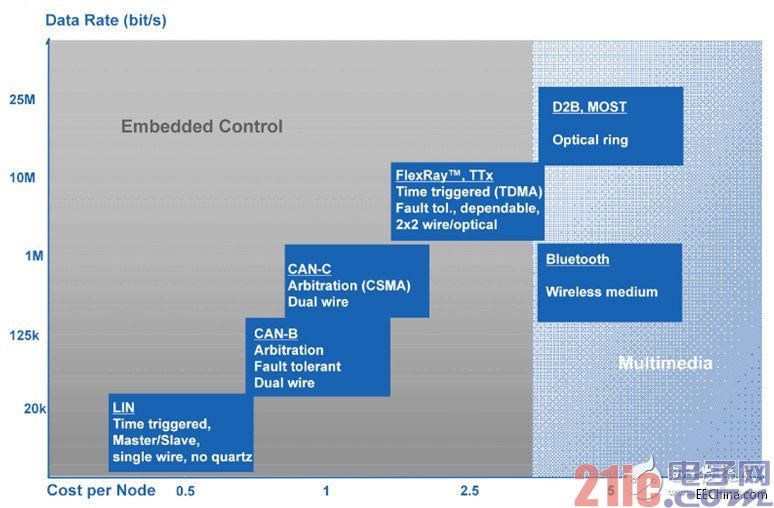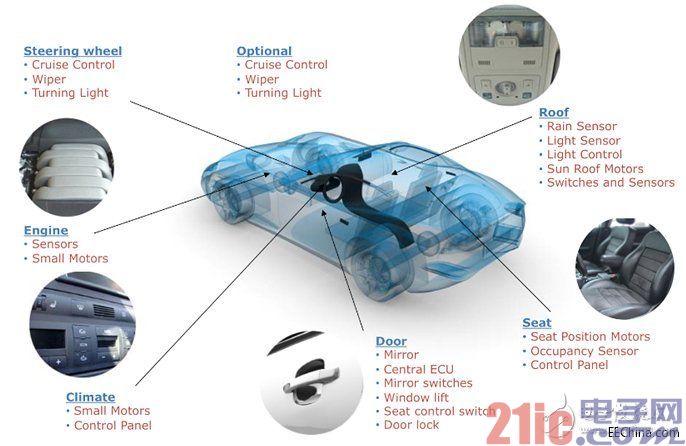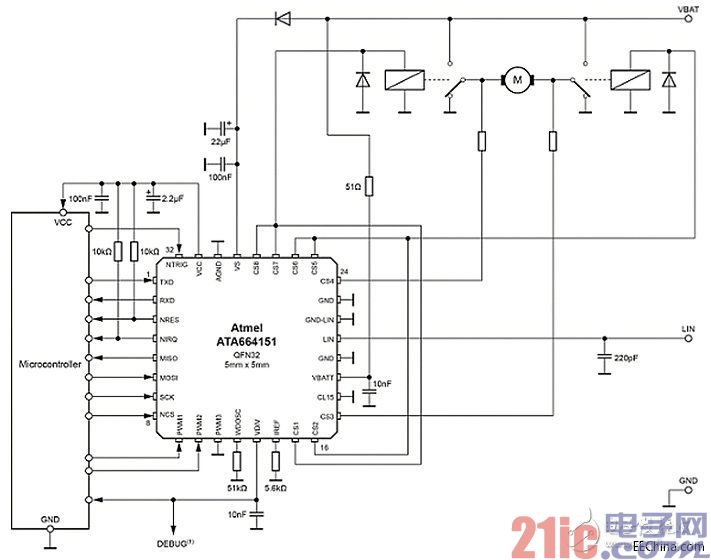
Privacy statement: Your privacy is very important to Us. Our company promises not to disclose your personal information to any external company with out your explicit permission.
Summary
This article refers to the address: http://
Automakers have been keen to add value to their high-end brands with electronic systems such as infotainment and comfort controls. Functional configurations that were once exclusive to high-end models are now standard on the best-selling models. Automotive electronics systems are now seen as an important difference in competitiveness. As a result, microcontrollers are becoming ubiquitous devices in automobiles. At present, a major challenge for automotive electronics system design engineers is how to ensure communication between applications and systems in the car. The key is the interface.
Foreword
The trend of using various electronic systems in automobiles is increasing. These systems have become ubiquitous in all car categories and models. Electronic systems are no longer proprietary to high-end models, and the use of electronic systems to implement every function and feature of a car has been seen as a way to make a brand stand out. According to the 2013 Automotive Electrical and Electronic Systems Report, the cost of electronic systems accounts for 40% of the total cost of traditional models and 75% of the total cost of electric and hybrid models.
The chip company's ability to integrate many complex functions is one of the main drivers of this growth. The required integration to achieve control, infotainment, and other applications means that some parts of the traditional harness have been replaced by various network buses for integration purposes.
Common methods for connecting various automotive applications
Two common automotive application network standards are CAN (Controller Area Network) and LIN (Local Area Network). In order to minimize wiring, both protocols use serial communication. Multiple networks using both standards can be found in any modern car, each responsible for a specific application area. The CAN network has a multi-master topology and is therefore used to connect multiple electronic control units (ECUs). In contrast, the LIN bus supports a single-master topology and is therefore typically used to interconnect one active ECU with one or more less intelligent dedicated slave nodes.
A common implementation of the CAN bus is a balanced differential 2-wire interface with non-return-to-zero (NRZ) encoding. Typical data rates are up to 1 Mb/s. It uses an asynchronous method to broadcast messages to all nodes in the network. Any node can send a message as long as the bus is idle. It uses a conflict arbitration and resolution that does not require retrying to ensure that the highest priority message is sent. The CAN standard (ISO11898) defines four different message types: data frames, remote transmission request frames, error frames, and overload frames.
CAN provides a fast, flexible, and comprehensive way to interconnect multiple controllers, enabling applications to share sensor inputs and other data. Despite this, for simpler applications such as window control, car manufacturers believe that their higher speed and versatility are unnecessary and that their implementation costs are too high. The LIN Association was founded in 1999 by a number of leading automotive manufacturers. LIN offers a single-wire bus that complies with an enhanced version of the ISO9141 specification, which has been used for on-board diagnostics since the 1980s. There can be only one master node on a LIN bus, but there can be one or more slave nodes. Typical data rates are 20 kb/s or less, which also helps to minimize electromagnetic interference. Low cost LIN systems are commonly used in automotive comfort, sensor and actuator applications.
Figure 1 shows the various automotive network bus types and their typical data rates and relative cost per node.

Figure 1 – Cost comparison per node for various automotive network protocols
To meet the needs of automotive electronics system designers, Atmel offers them a complete line of devices for CAN and LIN applications. Atmel's LIN portfolio includes stand-alone transceivers, System Basis Chips (SBCs) with integrated transceivers, a voltage regulator and other features, and System-in-Package and Specialty (ASSP) devices based on Atmel AVR microcontrollers. Atmel's devices use BiPolarCMOS, CMOS and DMOS (BCD onSOI technology). They combine high voltage capability with silicon-on-insulator (SOI) technology to achieve high temperature operation, extremely low leakage current and latch-up resistance.

Figure 2 – Automotive LIN Application Example
high pressure
Figure 2 shows some application examples using LIN connections. These applications typically require high voltage devices that can efficiently control various 12V mechanical actuators directly from the car battery voltage. Examples of applications include: window lift, seat position adjustment, wiper and turbocharger flap control. A driver is usually built into the chip to provide up to 1 amp of current. In addition, an external MOSFET is required. Since the microcontroller cannot directly drive an external MOSFET, a built-in gate driver must be used. Common examples are H-bridge and B6 gate drivers. Any microcontroller used to control these applications requires an operating voltage that is lower than the car battery voltage, so a low dropout regulator is typically required to provide a stable voltage to the MCU.
An 8-bit Atmel microcontroller typically works in a small cluster of 10-16 LIN slave nodes that we can use for these applications while ensuring the required response time.
Immunity is likely to pose a major challenge for LIN applications. This is because the LIN bus can be up to several meters long and exposed to an electronic noise environment. Atmel's devices feature exceptionally reliable EMC/EMI (electromagnetic compatibility/electromagnetic interference) and 6 kV ESD (electrostatic discharge) immunity. Automakers stipulate that certain common standards must be followed, and Atmel's devices are certified by these standards. Atmel uses a very reliable SOI technology in its fail-safe LIN devices. Some of Atmel's LIN devices implement the lowest level of the LIN protocol software stack in hardware. Not only does this help significantly reduce bills of materials (BoM) for cost-sensitive applications, but it also frees up a lot of flash space for applications. In addition, Atmel works with a number of leading industry partners to ensure a complete, production-quality LIN protocol software stack.

Figure 3 – H-Bridge Control for Small DC Motors
Atmel's latest system-based chip ATA664151 allows designers to develop inexpensive and powerful master-slave nodes for LIN bus systems. It has an 8-channel high-voltage interface, a LIN transceiver that complies with LIN 2.2a and SAEJ2602-2, an adjustable WindowWatchdog and a low-dropout regulator that delivers 5V output voltage and up to 80mA. The AtmelATA664151 is designed for LIN switching applications and integrates almost the entire LIN node into one package. The powerful feature set of the ATA664151 makes it valuable for many other applications such as LED control, relay control, and external transistor control. Designers have the flexibility and flexibility to configure the ATA664151's high voltage port to match the desired application. In addition, the ATA664151 offers a variety of features that increase system robustness and reliability, such as overvoltage and undervoltage detection, overtemperature detection, high voltage port and supply voltage measurements.
Figure 3 shows an example of a motor control application using the ATA664151. This design may be more common in window lift applications where relays are used to provide bidirectional drive current to a DC motor. This design utilizes the parallel output capability of the ATA664151 to improve the current drive capability of the relay. As shown in this example, using only the ATA664151, an Atmel master MCU, and several passive components, we can design an ECU that is connected via LIN. To simplify the design, we can also integrate the ATA664151 and an AtmelATtiny167 MCU into one package.
September 19, 2022
September 09, 2022
September 08, 2022
September 09, 2022
November 03, 2022
이 업체에게 이메일로 보내기
September 19, 2022
September 09, 2022
September 08, 2022
September 09, 2022
November 03, 2022

Privacy statement: Your privacy is very important to Us. Our company promises not to disclose your personal information to any external company with out your explicit permission.

Fill in more information so that we can get in touch with you faster
Privacy statement: Your privacy is very important to Us. Our company promises not to disclose your personal information to any external company with out your explicit permission.